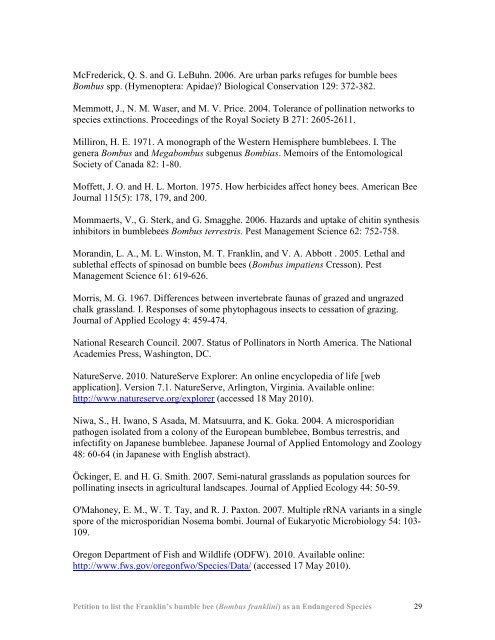Franklin's bumble bee - The Xerces Society
Franklin's bumble bee - The Xerces Society
Franklin's bumble bee - The Xerces Society
You also want an ePaper? Increase the reach of your titles
YUMPU automatically turns print PDFs into web optimized ePapers that Google loves.
McFrederick, Q. S. and G. LeBuhn. 2006. Are urban parks refuges for <strong>bumble</strong> <strong>bee</strong>s<br />
Bombus spp. (Hymenoptera: Apidae)? Biological Conservation 129: 372-382.<br />
Memmott, J., N. M. Waser, and M. V. Price. 2004. Tolerance of pollination networks to<br />
species extinctions. Proceedings of the Royal <strong>Society</strong> B 271: 2605-2611.<br />
Milliron, H. E. 1971. A monograph of the Western Hemisphere <strong>bumble</strong><strong>bee</strong>s. I. <strong>The</strong><br />
genera Bombus and Megabombus subgenus Bombias. Memoirs of the Entomological<br />
<strong>Society</strong> of Canada 82: 1-80.<br />
Moffett, J. O. and H. L. Morton. 1975. How herbicides affect honey <strong>bee</strong>s. American Bee<br />
Journal 115(5): 178, 179, and 200.<br />
Mommaerts, V., G. Sterk, and G. Smagghe. 2006. Hazards and uptake of chitin synthesis<br />
inhibitors in <strong>bumble</strong><strong>bee</strong>s Bombus terrestris. Pest Management Science 62: 752-758.<br />
Morandin, L. A., M. L. Winston, M. T. Franklin, and V. A. Abbott . 2005. Lethal and<br />
sublethal effects of spinosad on <strong>bumble</strong> <strong>bee</strong>s (Bombus impatiens Cresson). Pest<br />
Management Science 61: 619-626.<br />
Morris, M. G. 1967. Differences between invertebrate faunas of grazed and ungrazed<br />
chalk grassland. I. Responses of some phytophagous insects to cessation of grazing.<br />
Journal of Applied Ecology 4: 459-474.<br />
National Research Council. 2007. Status of Pollinators in North America. <strong>The</strong> National<br />
Academies Press, Washington, DC.<br />
NatureServe. 2010. NatureServe Explorer: An online encyclopedia of life [web<br />
application]. Version 7.1. NatureServe, Arlington, Virginia. Available online:<br />
http://www.natureserve.org/explorer (accessed 18 May 2010).<br />
Niwa, S., H. Iwano, S Asada, M. Matsuurra, and K. Goka. 2004. A microsporidian<br />
pathogen isolated from a colony of the European <strong>bumble</strong><strong>bee</strong>, Bombus terrestris, and<br />
infectifity on Japanese <strong>bumble</strong><strong>bee</strong>. Japanese Journal of Applied Entomology and Zoology<br />
48: 60-64 (in Japanese with English abstract).<br />
Öckinger, E. and H. G. Smith. 2007. Semi-natural grasslands as population sources for<br />
pollinating insects in agricultural landscapes. Journal of Applied Ecology 44: 50-59.<br />
O'Mahoney, E. M., W. T. Tay, and R. J. Paxton. 2007. Multiple rRNA variants in a single<br />
spore of the microsporidian Nosema bombi. Journal of Eukaryotic Microbiology 54: 103-<br />
109.<br />
Oregon Department of Fish and Wildlife (ODFW). 2010. Available online:<br />
http://www.fws.gov/oregonfwo/Species/Data/ (accessed 17 May 2010).<br />
Petition to list the Franklin’s <strong>bumble</strong> <strong>bee</strong> (Bombus franklini) as an Endangered Species 29
















